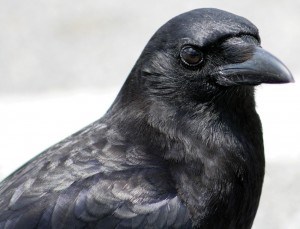
A week ago, as I drove across the Moberly Bridge with a friend and our kids, we noticed a rather large congregation of ravens sitting on the banks of the Athabasca River. At first we assumed a kill—perhaps a bull elk hunted to its demise by a local wolf pack and left for the scavengers to clean to the bone.
Naturally, we pulled over. You never know what animals will show up to a carrion party. But upon closer inspection, there was no apparent kill, and what’s more, these were not ravens at all, they were their smaller cousins: crows. And there were far, far more of them then we had originally assumed.
In fact, as I walked to the edge of the road to investigate, the flock took flight, hundreds of them washing over me in horror movie fashion. Amid the cawing and too-close-for-comfort whooshing of wings, I could hear the kids screaming “Whoooooaaaaaaahhhhh!” in the car behind me. A semi-driver honked in excitement as he barrelled by.
I had to wonder, besides testing the strength of my heart, what were these crows doing there?
Well, it turns out, crows often pack up in large groups to head south. Unlike ravens, crows don’t live here—they go back to their home territories in the milder climes of the lower 48 states, although a few may eke out a winter in warmer parts of Canada. This has been going on since crows were crows, yet somehow, this migration has escaped me for most of my life.
Scientists call their flight home a partial migration, as compared to the much longer migrations many other bird species make to Mexico and Central America.
Sometimes, the number of individuals travelling in these aerial flash mobs can be quite large. In one account, an observer said the “sky darkened as they passed,” while another called a group stop along the way a “crow invasion.”
While some feel the presence of crows is ominous, it seems this behaviour is entirely natural, and, as I learned from getting up close and personal, quite exhilarating to witness.
The number of crows in these large groups reaches its peak when crows return to their communal sleeping area, or roosts. These roosts can be as small as a couple hundred birds, but some are up to two million strong, according to the Cornell Lab of Ornithology. Imagine the noise emanating from a group of crows that large.
It would be incredible to experience, but if you had to live with it, you’d almost certainly need cement earplugs.
No one knows the exact reason for roosting, but it may be related to protection from predators, shelter from weather, or access to food. There may also be something for crows to gain in terms of social connection, or learning from one another—but our understanding of crow behaviour is still evolving.
Especially mine, apparently. So I ask you Jasper and friends thereof, what do you know about the crows around here? Sure we all have a favourite raven or two, but how about a special crow?
Have you seen large flocks getting ready to head south? I for one want to know if you’ve witnessed a crow getting away with its murder.
If you have an answer for Niki, send it along to [email protected] and perhaps you’ll see it printed in a future edition of the Fitzhugh.
Niki Wilson
Special to the Fitzhugh
